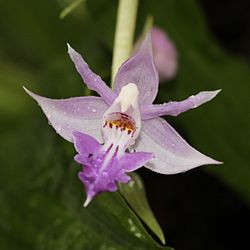| Calanthe puberula | |
 | |
| Systematics | |
|---|---|
| Domain | Eukaryotes Eukaryotic |
| Kingdom | Plants Plantae |
| Division | Vascular plants Tracheophyta |
| Class | Monocot flowering plants Liliopsida |
| Order | Asparagales Asparagales |
| Family | Orchids Orchidaceae |
| Genus | Calanthe |
| Species | Calanthe puberula |
| Scientific name | |
| §Calanthe puberula | |

Alismorkis puberula (Lindley) Kuntze; Calanthe amoena W. W. Smith; C. lepida W. W. Smith;Paracalanthe reflexa (Maximowicz) Kudô var. puberula (Lindley) Kudô.
Plants 25-60 cm tall. Rhizome usually inconspicuous. Pseudobulbs narrowly cylindric, ca. 2 × 1.5 cm, enclosed in leaf sheaths. Leaves 4 or 5, basal, well developed at anthesis, not deciduous; blade elliptic or elliptic-oblong, 12-22 × 5-7 cm, glabrous or sparsely puberulent along veins abaxially, with 5 main veins, apex acute or acuminate; petiole-like base to 13 cm. Scapes 1 or 2, arising from near apex of pseudobulb, erect, 23-40 cm, slender, with several lanceolate sterile bracts; rachis 6-14 cm, laxly 4-10-flowered; floral bracts persistent, lanceolate, 13-20 mm, abaxially puberulent, apex long acuminate. Flowers pink; pedicel and ovary 15-20 mm, densely puberulent. Sepals similar, ovate-lanceolate, 11-16(-20) × ca. 5 mm, abaxially puberulent, 5-veined, apex cuspidate; lateral sepals oblique. Petals linear, 11-13 × 1-2(-3) mm, 1-3-veined, apex acuminate; lip adnate to base of column wings, 11-13 × 6-11 mm, spurless, 3-lobed; lateral lobes oblong-falcate, 7-9 mm across their apices, margin entire, apex obtuse; mid-lobe rhombic-elliptic to obovate-cuneate, apical margin irregularly dentate or fringed, apex acute; disk without lamellae or calli. Column ca. 6 mm, glabrous; rostellum 3-lobed; anther cap narrowly ovate-cordate, ca. 4 mm; pollinia clavate, ca. 2 mm, with conspicuous caudicles; viscidium linear, ca. 1 mm. Fl. Jun-Aug. 2n = 40, 40 + 1B, 42.
Evergreen broad-leaved forests; 1200-3000 m. SE Xizang, SE and W Yunnan [Bhutan, NE India, Japan, Nepal, N Vietnam].
CITIES category : Appendix II
References
1.Ref 1
2.Ref 2
3.Ref 3
No comments:
Post a Comment